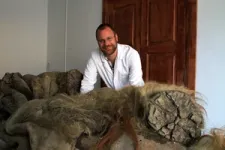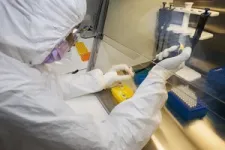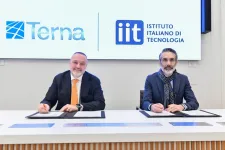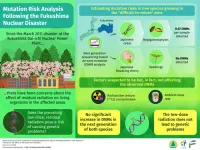(Press-News.org) A team of researchers compared the genomes of woolly mammoths with modern day elephants to find out what made woolly mammoths unique, both as individuals and as a species. The investigators report April 7 in the journal Current Biology that many of the woolly mammoth’s trademark features—including their woolly coats and large fat deposits—were already genetically encoded in the earliest woolly mammoths, but these and other traits became more defined over the species’ 700,000+ year existence. They also identified a gene with several mutations that may have been responsible for the woolly mammoth’s miniscule ears.
“We wanted to know what makes a mammoth a woolly mammoth,” says paleogeneticist and first author David Díez-del-Molino (@indianadiez) of the Centre for Palaeogenetics in Stockholm. “Woolly mammoths have some very characteristic morphological features, like their thick fur and small ears, that you obviously expect based on what frozen specimens look like, but there are also many other adaptations like fat metabolism and cold perception that are not so evident because they’re at the molecular level.”
To identify genes that were “highly evolved” in woolly mammoths— meaning they had accrued a large number of mutations—the team compared the genomes of 23 Siberian woolly mammoth with 28 modern-day Asian and African elephant genomes. Twenty-two of these woolly mammoths were relatively modern, having lived within the past 100,000 years, and sixteen of the genomes had not been previously sequenced. The twenty-third woolly mammoth genome belonged to one of the oldest known woolly mammoths, Chukochya, who lived approximately 700,000 years ago.
“Having the Chukochya genome allowed us to identify a number of genes that evolved during the lifespan of the woolly mammoth as a species,” says senior author Love Dalén (@love_dalen), professor of evolutionary genomics at the Centre for Palaeogenetics in Stockholm. “This allows us to study evolution in real time, and we can say these specific mutations are unique to woolly mammoths, and they didn't exist in its ancestors.”
Not surprisingly, many genes that were adaptive for woolly mammoths are related to living in cold environments. Some of these genes are shared by unrelated modern-day Arctic mammals. “We found some highly evolved genes related to fat metabolism and storage that are also found in other Arctic species like reindeer and polar bears, which means there’s probably convergent evolution for these genes in cold-adapted mammals,” says Díez-del-Molino.
While previous studies have looked at the genomes of one or two woolly mammoths, this is the first comparison of a large number of mammoth genomes. This large sample size enabled the team to identify genes that were common among all woolly mammoths, and therefore likely adaptive, as opposed to genetic mutations that might only have been present in a single individual.
“We found that some of the genes that were previously thought to be special for woolly mammoths are actually variable between mammoths, which means they probably weren't as important,” says Díez-del-Molino.
Overall, the 700,000-year-old Chukochya genome shared approximately 91.7% of the mutations that caused protein-coding changes in the more modern woolly mammoths. This means that many of the woolly mammoth’s defining traits—including thick fur, fat metabolism, and cold-perception abilities—were probably already present when the woolly mammoth first diverged from its ancestor, the steppe mammoth.
However, these traits developed further in Chukochya’s descendants. “The very earliest woolly mammoths weren't fully evolved,” says Dalén “They possibly had larger ears, and their wool was different—perhaps less insulating and fluffy compared to later woolly mammoths.”
More modern woolly mammoths also had several immune mutations in T cell antigens that were not seen in their ancestor. The authors speculate that these mutations may have conferred enhanced cell-mediated immunity in response to emerging viral pathogens.
Working with ancient mammoth DNA comes with a slew of hurdles. “Every step of the way, things are a bit more difficult, from fieldwork, to lab work, to bioinformatics,” says Díez-del-Molino.
“Apart from the field work, where we have to battle both polar bears and mosquitos, another aspect that makes this much more difficult is that you have to work in an ancient DNA laboratory, and that means that you have to dress up in this full-body suit with a hood and face mask and visor and double gloves, so doing the lab work is rather uncomfortable to put it mildly,” says Dalén. “I would like to highlight Marianne Dehasque, the second author of this paper, who did the herculean effort of performing lab work on most of these samples.”
All the mammoths whose genomes were included in this study were collected in Siberia, but the researchers hope to branch out and compare North American woolly mammoths in the future. “We showed a couple of years ago that there was gene flow between woolly mammoths and the ancestors of Colombian mammoths, so that’s something that we will need to account for because North American woolly mammoths might have been carrying non-woolly mammoth genes as well,” says Dalén.
###
This research was supported by the Swedish Research Council, FORMAS, the Carl Tryggers Foundation, the SciLifeLab, the Wallenberg Data Driven Life Science Program, the Wallenberg Academy, and the Russian Science Foundation.
Current Biology, Díez-del-Molino et al. ‘Genomics of adaptive evolution in the woolly mammoth’ https://www.cell.com/current-biology/fulltext/S0960-9822(23)00404-9
Current Biology (@CurrentBiology), published by Cell Press, is a bimonthly journal that features papers across all areas of biology. Current Biology strives to foster communication across fields of biology, both by publishing important findings of general interest and through highly accessible front matter for non-specialists. Visit: http://www.cell.com/current-biology. To receive Cell Press media alerts, contact press@cell.com.
END
About The Study: In this randomized clinical trial, anakinra did not prevent the need for mechanical ventilation or reduce mortality risk compared with standard of care alone among hospitalized patients with severe COVID-19 pneumonia. Future research should assess anakinra in patients with less severe pneumonia.
Authors: Patricia Fanlo, M.D., Ph.D., of the Hospital Universitario de Navarra in Pamplona, Spain, is the corresponding author.
To access the embargoed study: Visit our For The Media ...
About The Study: This national-level analysis found substantial adverse maternal outcomes among pregnant patients with COVID-19 infection at delivery during the early pandemic in the U.S. Specifically, the odds of severe respiratory complications were increased among pregnant patients with COVID-19 infection at delivery.
Authors: Koji Matsuo, M.D., Ph.D., of the University of Southern California in Los Angeles, is the corresponding author.
To access the embargoed study: Visit our For The Media website at this link https://media.jamanetwork.com/
(doi:10.1001/jamanetworkopen.2023.7149)
Editor’s ...
Can a school-based sexual health education program that effectively reduces the risk of unintended pregnancy and STIs also decrease homophobia and transphobia?
That question drove a collaborative effort by researchers conducting a randomized controlled trial of an inclusive comprehensive sex education program – High School FLASH. The study evaluated not just the impact on students’ sexual behaviors and related outcomes but also on their homophobic and transphobic beliefs (Coyle et al., 2021). With funding from the U.S. Department of Health and Human Services, researchers evaluated High School FLASH in 20 schools in two U.S. regions (Midwest and South). ...
Rome (Italy), 7th April 2023 - Terna, the company led by Stefano Donnarumma that manages the national transmission grid, and Istituto Italiano di Tecnologia (IIT- Italian Institute of Technology) have signed a five-year collaboration agreement aimed at studying and implementing innovative solutions in the field of robotics to support the company's field activities.
The agreement was signed on April 6th in Rome by Massimiliano Garri, Terna's Head of Innovation & Market Solutions, and Giorgio Metta, IIT Scientific Director.
"We are proud to start the collaboration with an excellence on the Italian ...
A new chip that holds different cell types in tiny, interconnected chambers could allow scientists to better understand the physiological and disease interactions between organs. The integrated-gut-liver-on-a-chip (iGLC) platform was designed by scientists at Kyoto University’s Institute for Integrated Cell-Material Sciences (iCeMS), to improve understanding of non-alcoholic fatty liver disease (NAFLD). The researchers, together with colleagues in Japan, published their findings in the journal Communications ...
This study is led by Dr.Ningli Wang and Dr.Yuan Xie (Beijing Tongren Hospital, Capital Medical University), they provide evidence that retinal microvasculature is a potential biomarker for cerebral microvasculature changes and acute mountain sickness(AMS) development during risk assessment of individuals at high altitudes.
Since the retinal and cerebral vasculature share many morphological and physiological characteristics, direct evaluation of the more accessible retinal vasculature should theoretically provide insights into the cerebral circulation. Therefore, the role of retinal imaging ...
CHAPEL HILL, N.C. – Glioblastoma is the most common type of brain tumor in adults. The disease is 100% fatal and there are no cures, making it the most aggressive type of cancer. Such a poor prognosis has motivated researchers and neurosurgeons to understand the biology of tumors with the goal of creating better therapies.
Dominique Higgins, MD, PhD, an assistant professor in the Department of Neurosurgery, has heeded the call. Higgins and a team of researchers at Columbia University have found ...
INDIANAPOLIS—For centuries, people have suspected a full moon in the sky to cause mysterious changes in people. Now, psychiatrists at Indiana University School of Medicine have found deaths by suicide increase during the full moon.
“We wanted to analyze the hypothesis that suicides are increased during the period around full moons and determine if high-risk patients should be followed more closely during those times,” said Alexander Niculescu, MD, PhD.
Niculescu and his team looked at data from the Marion County coroner’s ...
Imagine if you could ask a machine to “smell” something for you with just a click of a button. That’s what electronic noses, or e-noses, are for. They are systems that combine chemical gas sensors, signal processing and machine learning algorithms to mimic the sense of smell. E-noses can be used for many purposes, such as checking food quality, monitoring air pollution, diagnosing diseases and detecting explosives. How do they work? What are the challenges and opportunities in this field? A team led by Jingdong Chen of Northwestern Polytechnical University in Xi’an, China and ...
Ionizing radiation from nuclear disasters are known to be harmful to the natural environment. The Fukushima Dai-ichi Nuclear Power Plant meltdown that occurred in 2011 is a prominent example of such a disaster in recent memory. Even a decade after the incident, concerns remain about the long-term effects of the radiation. In particular, it is not clear how the residual low-dose radiation might affect living organisms at the genetic level.
The brunt of the disaster is usually borne by the floras inhabiting the contaminated areas since they cannot move. This, however, makes them ideal for ...









